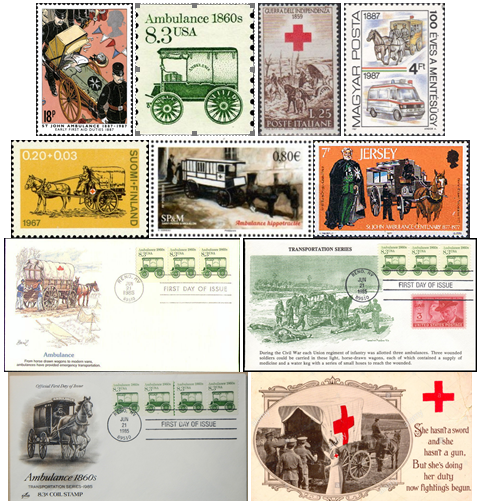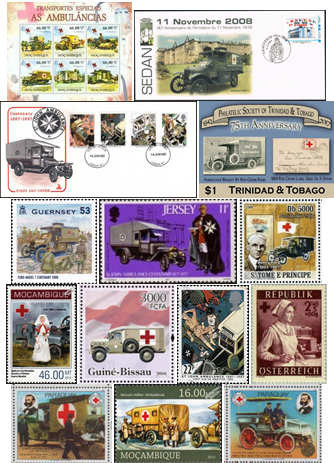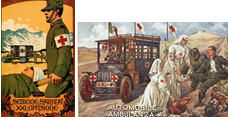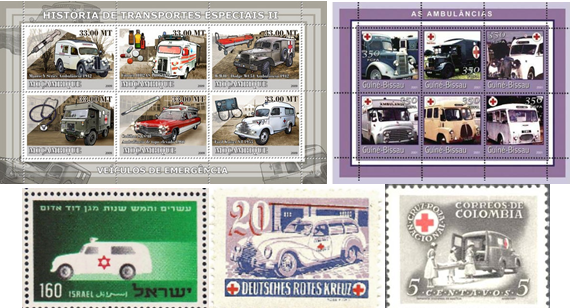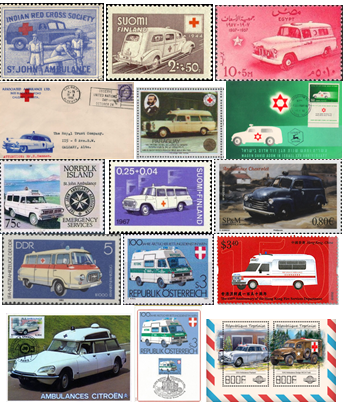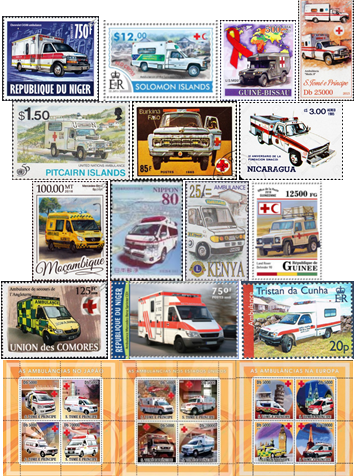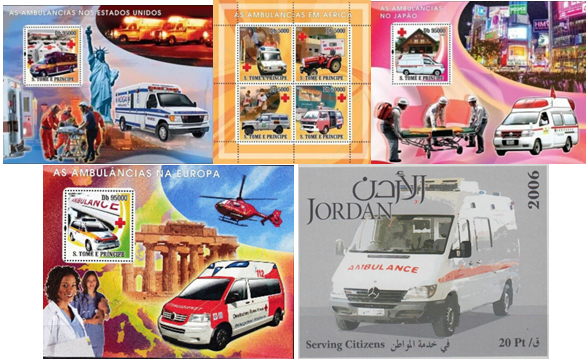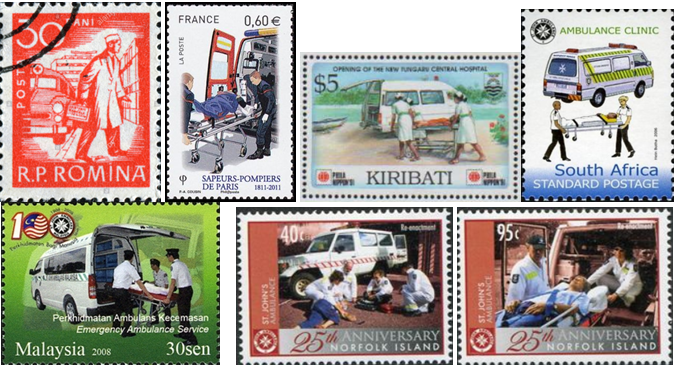Current Research in Emergency Medicine
[ ISSN : 2832-5699 ]
The History of the Development of Emergency Medical Services as Reflected by World Philately
The Petro Mohyla Black Sea State University, Nikolaev, Ukraine
Corresponding Authors
Keywords
Abstract
This article presents materials of research devoted to the reflection in the means of world philately of the questions concerning the practical activity of the “Ambulance” service and special medical land transport, the history of their creation and use in different countries of the world. It gives a selection of philatelic materials, representing the involvement of special vehicles in the medical care: horse-drawn carriages, wagons, cars of different designs and different years of operation, special ambulances.
Introduction
The history of the creation of the ambulance service throughout the world, providing it with special means of transport, from animal-drawn vehicles with the first ambulances to modern reanimobiles, is a bright page in the history of both medicine in general and emergency medicine and disaster medicine, in particular. The means of collecting: philately, numismatics, phaleristics, bonistics, etc., have not ignored the evolution and development of the “Ambulance” and special medical vehicles involved in the transportation to the scene of the accident of “Ambulance” teams of different specialization, as well as, delivery of patients and victims in various medical institutions [1,2]. This article will present the first materials of this subject.
Aim
The purpose of this article is to present research materials on the reflection in the means of modern philately, as an auxiliary applied science, different aspects, methods and means of providing the “Ambulance” service with special ground transport in different periods of time in different countries of the world.
Materials and methods
To achieve this goal, we used such methods of research as the analysis of available sources of information, using special literature on emergency medical care and the history of its creation and formation, Internet resources, philatelic catalogs, directories and thematic articles.
Results and discussion
After reviewing the available materials and sources of information on the issue under study, I would like to present a selection of philatelic materials received, devoted to the activities of the “Ambulance” services and special ground vehicles, different countries in different time periods, involved in the process of medical care and transportation of patients to hospitals. For example, Figure 1 shows a selection of postage stamps, postcards, and envelopes dedicated to the work of the world’s first and oldest ambulances, including wagons, carriages, and various types of animal drawn vehicles, and representing the medical care work of the time [3-5].
Numerous military actions, local military conflicts and wars, including World War I, have made various kinds of emergency ambulance transport necessary, both for the work of military medics on the battlefields, and for the transportation of the wounded and medicines, while ensuring the operation of hospitals and medical facilities. Although still in active demand, carts were already being superseded by medical service vehicles of various designs and uses. A selection of philatelic materials (postage stamps, an envelope, a block), representing special medical transport of the early twentieth century, is presented in Figure 2 [3-5].
The period of World War II and the early postwar period, in providing “ambulance” and assistance to the wounded and injured, is represented mainly by military specialized trucks, of different countries and brands, whose task was to evacuate the wounded from the battlefield to the nearest hospitals and to the rear for treatment. A selection of stamps, envelopes, and blocks representing this time period and special medical transport of those years is shown in Figure 3 [3-5].
Figure 1: The first special means of medical transport
Figure 2: Special medical transport of the early twentieth century
Figure 3: Special medical transport during World War II
Figure 4: Medical transport of the 40-50s of the twentieth century
The postwar period, the second half of the 1940s and 50s, was represented by a rich variety of special medical vehicles used both in the ambulance service and in various other medical units. Figure 4, presents a rich variety of philatelic materials, a selection representing the means of special medical ground transport of that time [Figure 4].
Since the 1960s and 1980s, against the background of the rapid development of medicine, economy, metallurgy and automobile industry, the introduction of new approaches and development concepts, the means of special medical transport were also rapidly changing. Cars for ambulance service, paramedic teams and medical rescue and disaster medicine services became more and more comfortable, of modern models and design, equipped with modern means of emergency assistance, both for the needs of civil medicine and for medical service of the armed forces of different countries. An extensive selection of various models of ambulances and special medical transport, up to the present day, reflected on postage stamps, blocks and envelopes, is shown in Figure 5 [3-5].
Figure 5: Modern special medical transport
At the end of the article, in Figure 6, we would like to present a selection of philatelic materials of different countries, devoted to the selfless work of medical workers - doctors, paramedics, nurses, paramedics, orderlies and drivers, in rendering emergency medical aid to the sick and injured people. These people are the first to arrive at patients, and on their professional and coordinated actions, the life and health of all those people to whom they provide this medical care depend [3-5].
Figure 6: The work of ambulance crews and paramedics on postage stamps
The material in this article is only part of a larger study concerning the reflection of ambulance and emergency medical personnel in collectibles. The following articles will be devoted to the reflection of these medical services on coins, banknotes, awards and badges, as well as in other philatelic materials not included in this article.
Conclusions
1. Collectibles, including philately, are an interesting way to impart additional and informative information on the study of emergency medicine.
2. The use of this article and similar research papers in addition to the study of basic clinical disciplines will help students, trainees, medical professionals, and anyone else who cares about emergency medicine to broaden their horizons and enrich their knowledge of the issue at hand.
Conflict of interest:
The author notes the complete absence of any conflicts of interest.
References
- Bugaevsky KA (2019) Military field surgery and assistance to the wounded and injured in the reflection of philately. In: Levchuk IP, Kostyuchenko MVM (Eds.), Proceedings of the VI All-Russian scientific-practical Olympiad of students and young scientists on disaster medicine. Moscow: N.I. Pirogov Russian National Research Medical University, Russia, "White Wind" P. 11-17.
- Bugaevsky KA (2017) Disaster Medicine in Reflection of World Philately Proceedings of IV All-Russian Scientific-Practical Olympiad of Students and Young Scientists on Disaster Medicine. In: Levchuk IP, Kostyuchenko MVM (Eds.), Moscow: N.I. Pirogov Russian National Research Medical University, Russia, P. 10-15.
- (2013) Catalog "Michele" of whole things of Eastern Europe (since 1966) / (Edition 8). In: Albert B (.Eds) Without place of publication. Michel, pp. 1098.
- San Martín de Río (2022) ELVIRA LÓPEZ MOURÍN GALICIAN NURSE. Nursing Advances.
- (2016) Scott specialized catalogue of World stamps. New York: Scott, рp. 876.
Citation: Bugaevsky KA (2022) The History of the Development of Emergency Medical Services as Reflected by World Philately. Curr Res Emerg Med 2: 1034


